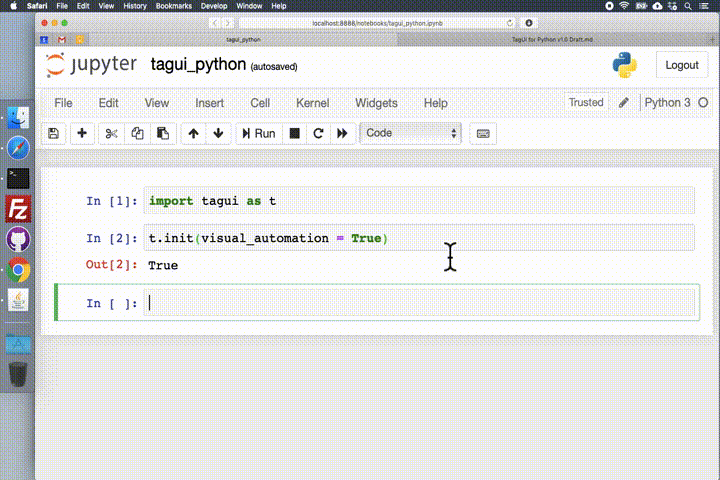Use Cases | API Reference | About & Credits | v1.17
To install this Python package for digital process automation (also known as RPA) -
pip install tagui
To use TagUI for Python in Jupyter notebook, Python script or interactive shell -
import tagui as tTo deploy in environments without internet, let me know your constraints here -
t.init(); t.url('https://github.com/tebelorg/TagUI-Python/issues/36')Notes on different operating systems and optional visual automation mode -
- Windows users - if visual automation is cranky, try setting your display zoom level to recommended % or 100%
- macOS users - Catalina update introduces tighter app security, see solutions for PhantomJS and Java popups
- Linux users - visual automation mode requires special setup on Linux, see how to install OpenCV and Tesseract
TagUI for Python's simple, expressive and powerful API makes digital process automation fun and easy!
t.init()
t.url('https://www.google.com')
t.type('q', 'decentralization[enter]')
t.snap('page', 'results.png')
print(t.read('resultStats'))
t.close()t.init(visual_automation = True)
t.dclick('outlook_icon.png')
t.click('new_mail.png')
...
t.type('message_box.png', 'message')
t.click('send_button.png')
t.close()t.init(visual_automation = True)
print(t.read('pdf_window.png'))
print(t.read('image_preview.png'))
t.hover('anchor_element.png')
print(t.read(t.mouse_x(), t.mouse_y(), t.mouse_x() + 400, t.mouse_y() + 200))
t.close()t.init(visual_automation = True, chrome_browser = False)
t.keyboard('[cmd][space]')
t.keyboard('safari[enter]')
t.keyboard('[cmd]t')
t.keyboard('joker[enter]')
t.wait(2.5)
t.snap('page.png', 'results.png')
t.close()t.init(visual_automation = True)
t.type(600, 300, 'open source')
t.click(900, 300)
t.snap('page.bmp', 'results.bmp')
t.hover('button_to_drag.bmp')
t.mouse('down')
t.hover(t.mouse_x() + 300, t.mouse_y())
t.mouse('up')
t.close()Check out sample Python script and RedMart groceries example.
-
For web automation, web element identifier can be XPath selector, CSS selector or the following attributes - id, name, class, title, aria-label, text(), href (in decreasing order of priority). There is automatic waiting for an element to appear before timeout happens, and error is returned that the element cannot be found. To change the default timeout of 10 seconds, use timeout() function.
-
An element identifier can also be a .png or .bmp image snapshot representing the UI element (can be on desktop applications or web browser). x, y coordinates of elements on the screen work as well. Transparency (0% opacity) is supported in .png images, for eg using an image of an UI element with transparent background to enable clicking on an UI element that appears on different backgrounds on different occasions.
-
A further example is an image of the window or frame (PDF viewer, MS Word, textbox etc) with the center content of the image set as transparent. This allows using read() and snap() to perform OCR and save snapshots of application windows, containers, frames, textboxes with varying content. Also for read() and snap(), x1, y1, x2, y2 coordinates pair can be used to define the region of interest on the screen to perform OCR or capture snapshot.
| Function | Parameters | Purpose |
|---|---|---|
| init() | visual_automation = False, chrome_browser = True | start TagUI, auto-call setup() on first run |
| close() | close TagUI, Chrome browser, SikuliX | |
| setup() | setup TagUI to user home folder | |
| pack() | (beta feature - let me know your constraints here) | for deployment without internet |
| Function | Parameters | Purpose |
|---|---|---|
| debug() | True or False | toggle debug mode, ie print and log debug info |
| send() | tagui_instruction | send TagUI instruction to TagUI for execution |
| Function | Parameters | Purpose |
|---|---|---|
| url() | webpage_url (no parameter to return current URL) | go to web URL |
| click() | element_identifier (or x, y using visual automation) | left-click on element |
| rclick() | element_identifier (or x, y using visual automation) | right-click on element |
| dclick() | element_identifier (or x, y using visual automation) | double-click on element |
| hover() | element_identifier (or x, y using visual automation) | move mouse to element |
| type() | element_identifier (or x, y), text_to_type ('[enter]', '[clear]') | enter text at element |
| select() | element_identifier (or x, y), option_value (or x, y) | choose dropdown option |
| read() | element_identifier (page = web page) (or x1, y1, x2, y2) | fetch & return element text |
| snap() | element_identifier (page = web page), filename_to_save | save screenshot to file |
| load() | filename_to_load | load & return file content |
| dump() | text_to_dump, filename_to_save | save text to file |
| write() | text_to_write, filename_to_save | append text to file |
| echo() | text_to_echo | print text to screen |
| ask() | text_to_prompt | ask & return user input |
| Function | Parameters | Purpose |
|---|---|---|
| keyboard() | keys_and_modifiers (using visual automation) | send keystrokes to screen |
| mouse() | 'down' or 'up' (using visual automation) | send mouse event to screen |
| wait() | delay_in_seconds (default 5 seconds) | explicitly wait for some time |
| check() | condition_to_check, text_if_true, text_if_false | check condition & print result |
| table() | element_identifier (XPath only), filename_to_save | save basic HTML table to CSV |
| upload() | element_identifier (CSS only), filename_to_upload | upload file to web element |
| download() | download_url, filename_to_save(optional) | download from URL to file |
| unzip() | file_to_unzip, unzip_location (optional) | unzip zip file to specified location |
| frame() | main_frame id or name, sub_frame (optional) | set web frame, frame() to reset |
| popup() | string_in_url (no parameter to reset to main page) | set context to web popup tab |
| run() | command_to_run (use ; between commands) | run OS command & return output |
| dom() | statement_to_run (JS code to run in browser) | run code in DOM & return output |
| vision() | command_to_run (Python code for SikuliX) | run custom SikuliX commands |
| timeout() | timeout_in_seconds (blank returns current timeout) | change wait timeout (default 10s) |
keyboard() - modifiers and special keys
[shift] [ctrl] [alt] [cmd] [win] [meta] [clear] [space] [enter] [backspace] [tab] [esc] [up] [down] [left] [right] [pageup] [pagedown] [delete] [home] [end] [insert] [f1] .. [f15] [printscreen] [scrolllock] [pause] [capslock] [numlock]
| Function | Parameters | Purpose |
|---|---|---|
| exist() | element_identifier | return True or False if element exists before timeout |
| present() | element_identifier | return True or False if element is present now |
| count() | element_identifier | return number of web elements as integer |
| clipboard() | text_to_put or no parameter | put text or return clipboard text as string |
| coord() | x_coordinate, y_coordinate | return string '(x,y)' from integers x and y |
| mouse_xy() | return '(x,y)' coordinates of mouse as string | |
| mouse_x() | return x coordinate of mouse as integer | |
| mouse_y() | return y coordinate of mouse as integer | |
| title() | return page title of current web page as string | |
| text() | return text content of current web page as string | |
| timer() | return time elapsed in sec between calls as float |
TagUI is the number #1 open-source RPA software with thousands of active users. It was created in 2016-2017 when I left DBS Bank as a test automation engineer, to embark on a one-year sabbatical to Eastern Europe. Most of its code base was written in Novi Sad Serbia. My wife and I also spent a couple of months in Budapest Hungary, as well as Chiang Mai Thailand for visa runs. In 2018, I joined AI Singapore to continue development of TagUI.
Over the past 2 months I took on a daddy role full-time, taking care of my newborn baby girl and wife. In between nannying and caregiving, I decided to use my time pockets to create a Python package for TagUI. I would like to bring RPA into the heart of machine learning - the Python ecosystem. I hope that TagUI for Python and ML frameworks would be a match made in heaven, and pip install tagui would make lives easier for Python users.
Lastly, at only ~1k lines of code, it would make my day to see developers of other languages porting this project over to their favourite coding language. See the ample comments in this single-file package, and its intuitive architecture -
I would like to credit and express my appreciation below, and you are invited to connect on LinkedIn -
- TagUI - AI Singapore from Singapore / @aisingapore
- SikuliX - Raimund Hocke from Germany / @RaiMan
- CasperJS - Nicolas Perriault from France / @n1k0
- PhantomJS - Ariya Hidayat from Indonesia / @ariya
- SlimerJS - Laurent Jouanneau from France / @laurentj
TagUI for Python is open-source software released under Apache 2.0 license


